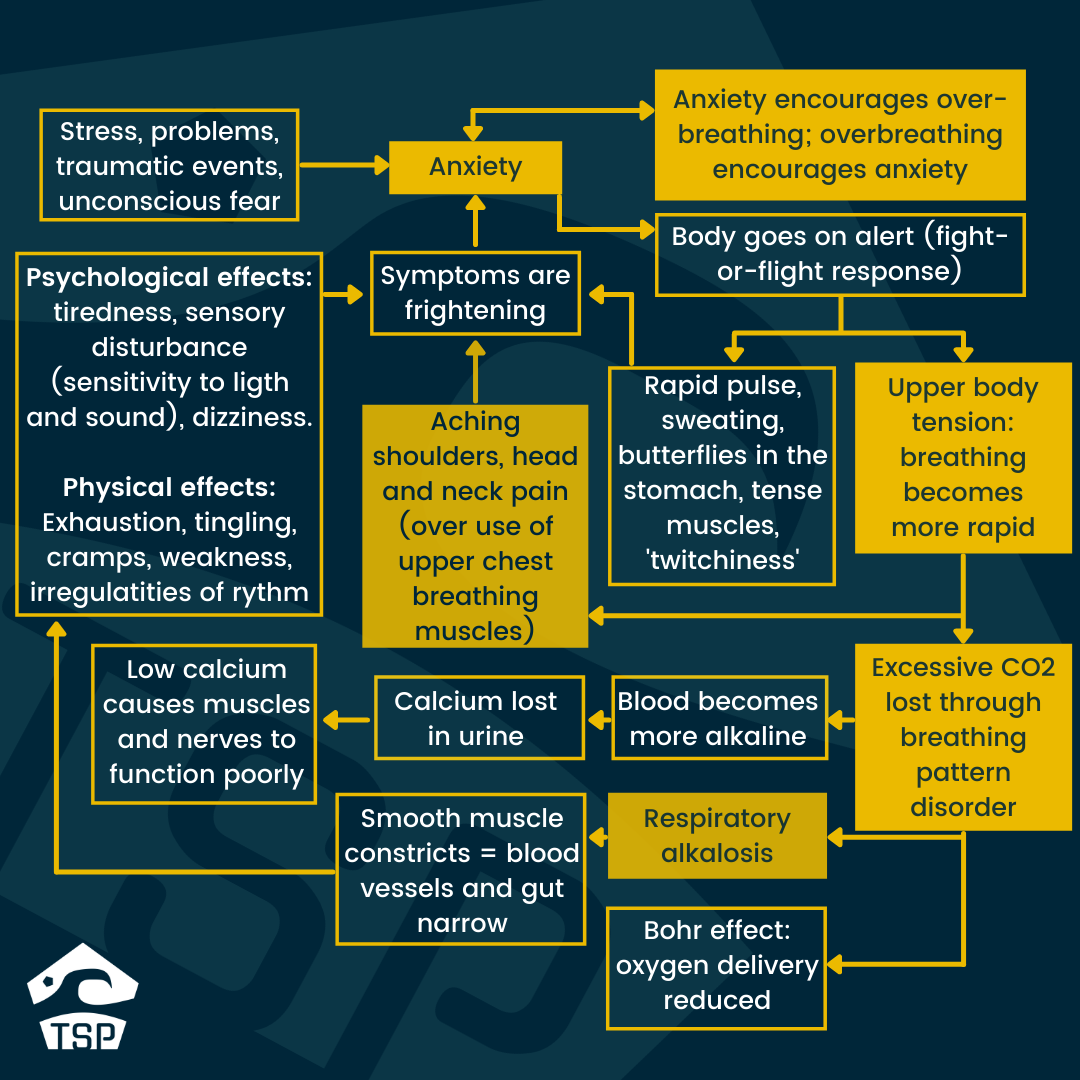Breathing for surfers
Sep 7
/
Pere Campistol Agustí
How do you breathe when surfing?
The answer is...it really depends on the physiological demands of the effort. When you google 'how to breathe when surfing' the first search results will take you to videos or articles teaching belly breathing techniques. In my opinion, these have the right intention, but not the best instruction. The fact is the way we communicate with our surf athletes is crucial if we want them to achieve transformational results...So let's break this question down.
First, having a basic understanding of breathing mechanics (i.e. primary and accessory respiratory muscles involves in inhalation and exhalation) is a must.
First, having a basic understanding of breathing mechanics (i.e. primary and accessory respiratory muscles involves in inhalation and exhalation) is a must.

In this slide from the breathing module of the Surf Foundation Specialist course we can observe the muscles responsible for inhalation and exhalation.
Lungs are not active structures, so what allows us to inhale and exhale? Breathing occurs as a result of changes in pressure gradients. And how do we facilitate these changes? Well, the diaphragm muscle plays a crucial role, especially during quiet breathing.
Lungs are not active structures, so what allows us to inhale and exhale? Breathing occurs as a result of changes in pressure gradients. And how do we facilitate these changes? Well, the diaphragm muscle plays a crucial role, especially during quiet breathing.
Right now, you are breathing as a result of diaphragmatic contractility and relaxation. The diaphragm is a dome-shaped muscle (it looks like a parachute) that separates the thoracic and abdominal cavities. Every time it contracts, it flattens, pulling the ribcage downwards and increasing the volume in the thoracic cavity, which will decrease the pressure inside the alveoli (the broccoli-like shaped structures in the lungs) and facilitate inhalation. During exhalation, the opposite occurs. This motion of the diaphragm during inhalation should increase intra-abdominal pressure equally in all directions (i.e. lower back, lateral abdominal walls and belly) and shouldn't be confused with belly breathing only.
We inhale to breath in oxygen (O2) and exhale to breath out carbon dioxide (CO2). When the demands of a particular effort (e.g. paddling) increase, the O2 demands of the working muscles will increase and the same will happen with the body's rate of CO2 elimination. The only way to achieve this is by increasing respiration (hyperpnea) to meet the demands of that effort. That's when accessory muscles of respiration come into play. During inhalation, rate of recruitment of external intercostals increases, and together with the sternocleidomastoid, scalene, pectoralis or serratus anterior muscles will assist in pulling the rib cage out (anteriorly and superior) to create a greater volume for the lungs to breathe, allowing more volume of gas to get in. The contrary will occur when the body needs to get rid of CO2 rapidly: internal intercostals, transversus thoracis, external and internal obliques and rectus abdominis will contract to assist with forceful exhalation.
Think about the accessory muscles of respiration like the turbocharger of a car. They should only be active when an intense effort requires an extra boost; during eco-driving, the turbo should be silent.
We inhale to breath in oxygen (O2) and exhale to breath out carbon dioxide (CO2). When the demands of a particular effort (e.g. paddling) increase, the O2 demands of the working muscles will increase and the same will happen with the body's rate of CO2 elimination. The only way to achieve this is by increasing respiration (hyperpnea) to meet the demands of that effort. That's when accessory muscles of respiration come into play. During inhalation, rate of recruitment of external intercostals increases, and together with the sternocleidomastoid, scalene, pectoralis or serratus anterior muscles will assist in pulling the rib cage out (anteriorly and superior) to create a greater volume for the lungs to breathe, allowing more volume of gas to get in. The contrary will occur when the body needs to get rid of CO2 rapidly: internal intercostals, transversus thoracis, external and internal obliques and rectus abdominis will contract to assist with forceful exhalation.
Think about the accessory muscles of respiration like the turbocharger of a car. They should only be active when an intense effort requires an extra boost; during eco-driving, the turbo should be silent.
Second, we need to understand the causes and consequences of dysfunctional breathing patterns. Why is every fitness enthusiast insisting on restoring breathing patterns? Dysfunctional breathing mechanics seem prevalent in the modern world for several reasons (we won't go down the rabbit hole in this post). The causes and consequences of impaired breathing mechanics come in many shapes and may include:
- hyperventilation as a consequence of an extreme breathing pattern alteration
- psychosocial problems
- shortened thoracic musculature
- restricted rib articulations
- anxiety

This table is adopted from the book 'Recognising and treating breathing disorders' by L. Chaitow & colleagues.
Some of these concepts (like the role of the Bohr effect on oxygen delivery to working muscles) may be overwhelming, but don't worry, we cover them on the Breathing Essentials chapter of the Surf Foundation Specialist course.
The take home message is that the consequences of impaired breathing mechanics go far beyond negatively impacting surf performance.
In the Surf Foundation Specialist course we use the OFCAT tool (Observe and listen, Feel, Cue, Ask and re-asses, and Train) to assess and enhance breathing mechanics from a seated and prone position (given breathing mechanics are posture-dependent). The rationale behind testing from a seated and prone position is due to its postural specificity to surfing.
Some of these concepts (like the role of the Bohr effect on oxygen delivery to working muscles) may be overwhelming, but don't worry, we cover them on the Breathing Essentials chapter of the Surf Foundation Specialist course.
The take home message is that the consequences of impaired breathing mechanics go far beyond negatively impacting surf performance.
In the Surf Foundation Specialist course we use the OFCAT tool (Observe and listen, Feel, Cue, Ask and re-asses, and Train) to assess and enhance breathing mechanics from a seated and prone position (given breathing mechanics are posture-dependent). The rationale behind testing from a seated and prone position is due to its postural specificity to surfing.
The last step of the OFCAT tool is train - you will need an array of solutions to 're-train' mechanics from different positions. Crocodile breathing and rope breathing are a great start to train resting mechanics, commonly referred to as diaphragmatic breathing. However, depending on your surfers' anatomy and biomechanics you can modify exercise prescription to bias certain movement patterns that will benefit different individuals. We will touch on this in our 8-week SFS Online Mentorship Program.
Write your awesome label here.
How can breathing improve surf paddling technique?
Once optimal breathing mechanics are achieved, we can move on and enhance our surfers' breathing support function. We know breathing occurs as a result of changes in pressure gradients within the thoracic cavity. In the thoracic cavity, the rib cage protects the heart and lungs. However, in the abdominal cavity the only skeletal support is the lumbar spine. A way to maintain postural support in the abdominal section is through breathing.
With proper breathing mechanics achieved through optimal diaphragmatic excursion, we can increase intra-abdominal pressure that together with optimal lengthening and static loading of the abdominal wall, will assist in maintaining optimal postural support.
DNS (Dynamic Neuromuscular Stabilization) practitioners have done an amazing job at conveying the importance of breathing for posture and movement. They promote optimal breathing mechanics and practice movement through different developmental milestones, with special attention on maintaining an ideal joint-centred position.
In the Surf Foundation Specialist course we explore a systematic approach to dry-land regressions and progressions to improve our surfers' breathing support (trunk and hip control) as it specifically relates to paddling and duck-diving.
With proper breathing mechanics achieved through optimal diaphragmatic excursion, we can increase intra-abdominal pressure that together with optimal lengthening and static loading of the abdominal wall, will assist in maintaining optimal postural support.
DNS (Dynamic Neuromuscular Stabilization) practitioners have done an amazing job at conveying the importance of breathing for posture and movement. They promote optimal breathing mechanics and practice movement through different developmental milestones, with special attention on maintaining an ideal joint-centred position.
In the Surf Foundation Specialist course we explore a systematic approach to dry-land regressions and progressions to improve our surfers' breathing support (trunk and hip control) as it specifically relates to paddling and duck-diving.
Write your awesome label here.
The video above gives you some great tools to introduce your surfers to the concept of breathing support. To learn more progressions check out the Surf Foundation Specialist online certification.
Write your awesome label here.
Join Waiting List!
Drop your email below, and we’ll keep you updated on everything about the launch of Power Surfer—the ultimate 12-month online strength training program for surfers.
Empty space, drag to resize
Thank you!

